Domesticity of Women in Society: Virtue and Gender Expectations
The role of women in seventeenth-century Dutch society is frequently associated with ideals of domesticity and virtue, reflecting the deeply ingrained values of the era. Women were often portrayed in genre paintings engaged in household activities such as cooking, sewing, or cleaning, clothed in modest attire that reinforced their association with domestic virtue. These depictions served a dual purpose: they illustrated prevailing social expectations and reinforced the patriarchal values that shaped women’s lives within Dutch society.
Domesticity and moral virtue were tightly interwoven in the public image of Dutch women, and art played a central role in this portrayal. Artists frequently depicted women as embodying specific virtues, using recurring symbols and motifs to convey moral lessons. For instance, objects surrounding women in these artworks—such as tidy kitchens, cooking pots, and carefully arranged household items—were laden with symbolism that reinforced the notion of female virtue tied to household management (fig. 1). This constructed image of the virtuous housewife reflected an idealized, prescriptive vision that functioned both descriptively and normatively, shaping societal expectations of women's behavior.
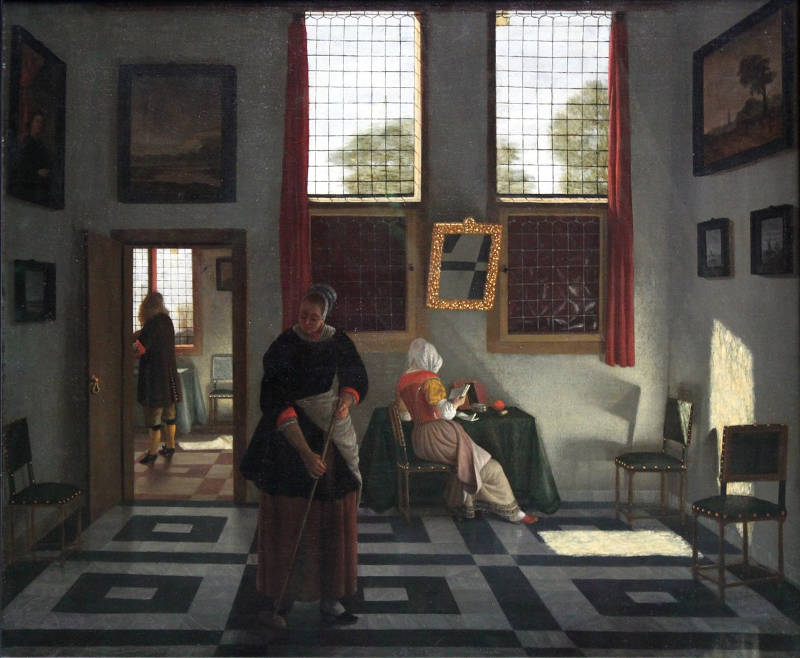
Pieter Janssens Elinga
c. 1668-1672
Oil on canvas, 62 x 59 cm.
Hermitage Museum, St Petersburg
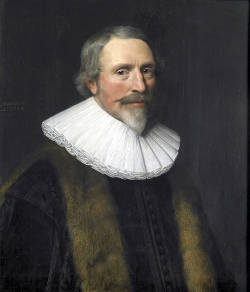
Michiel Jansz. van Mierevelt
1634
Oil on panel, 68.5 x 59.5 cm.
Museum Catharijneconvent, Rijksmuseum Amsterdam
The patriarchal structure of Dutch society further reinforced these values by idealizing distinct phases in a woman’s life, each associated with specific duties and virtues. Literature, particularly conduct books such as Houwelyck by Jacob Cats (1577–1660) (fig. 2), Jacob Cats, Houwelyck (Amsterdam: Jan Jacobsz Schipper, 1625). prescribed detailed behavioral expectations for women as they progressed through life stages—from maidenhood to marriage, motherhood, and widowhood. These life stages were demarcated by rigid duties and roles, fostering a societal system in which a woman’s virtue was measured by her adherence to these structured ideals.
However, the ubiquitous portrayal of women solely as paragons of virtue oversimplifies the complexity of gender relations within Dutch society. Genre paintings also occasionally depicted unruly women or chaotic households, introducing an element of moral ambiguity and societal critique. These works, while less common, hinted at underlying tensions in the societal expectations placed upon women. The coexistence of virtuous and transgressive female figures in Dutch art reflects the broader cultural discourse surrounding women’s roles, illustrating a nuanced approach to domestic imagery that allowed for multiple, sometimes conflicting interpretations.
The rigid portrayal of virtuous domesticity also reinforced the subordinate position of women within a firmly patriarchal system. Through both art and literature, men largely controlled the narrative surrounding women’s roles, often portraying them as passive figures within the domestic sphere. This cultural framing positioned men as the upholders of societal values, while women were viewed as instrumental to the moral structure of the home. As such, the representations of women in Dutch art from this period provide insight into how societal structures limited female agency, despite instances where women demonstrated resilience and adaptability within these constraints.
The structure and values embedded within Dutch society during the seventeenth century thus created a complex, multifaceted image of women. While the pervasive ideal of domestic virtue enforced a specific cultural vision of womanhood, it also highlighted the limits and pressures placed upon women, fostering an environment where female agency was defined within the narrow confines of a patriarchal order. Through an understanding of these artistic and cultural representations, one gains a richer perspective on the lives of Dutch women and the societal expectations they navigated in the early modern period.
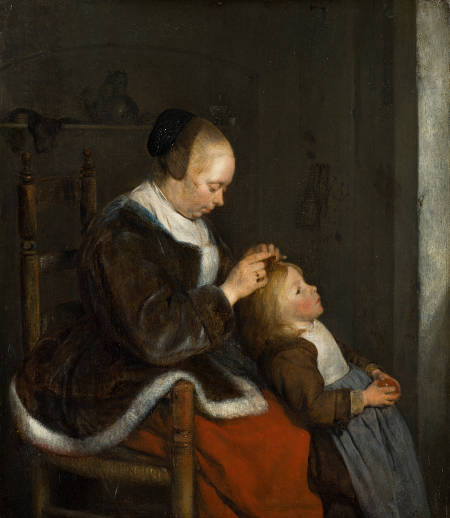
Gerrit ter Borch
?
Oil on panel, 33.2 x 28.7 cm.
Mauritshuis, The Hague
One Frenchman wrote, "Dutch women pride themselves on the cleanliness of their house and furniture to an unbelievable degree. They never seem to stop washing and scrubbing all the wooden furniture and fittings." Another visitor added, "They would prefer to die of hunger surrounded by their shining cauldrons and sparkling crockery rather than prepare any dish that might possibly disarrange this perfect symmetry—an observation frequently confirmed in the spotless kitchens portrayed in so many Dutch domestic interior paintings. Women are pictured checking their children for nits and lice (fig. 3) and ordering the maid to sweep the floor. The sitting room is tidy, and the beds are neatly stacked with pillows in their spotless linen cases. To get the linen perfectly white, housewives laid it out on bleaching fields.
Cleanliness

Willem van Odekercken
?
Oil on panel, 104.1 x 76.09 cm.
Private Collection
The Frenchman Parival wrote in 1651 about the Dutch obsession with cleanliness: "They wash and scrub incessantly," noting that "one doesn't dare spit in the rooms; it also is not the custom to spit in one's handkerchief; with the consequence that those who are phlegmatic are sorely put out."
Spring cleaning was described as a "frightful operation" by another French visitor, while the English author Brickman caustically observed that the Dutch kept "their houses cleaner than their persons, and their persons [cleaner] than their souls..."
Sir William Temple recounted a story shared by the Dutch in self-deprecation: a magistrate, upon visiting a gentlewoman's house, was accostedvby "a strapping North Holland lass [who], noting his shoes were not very clean, took him in both arms, threw him upon her back, carried him across two rooms, set him down at the bottom of the stairs, pulled off his shoes, put on him a pair of slippers ... all this without saying a word; but when she was done, told him he might go up to see her mistress."
This commitment to cleanliness could, of course, lead to excess, yet it was a source of national pride—a symbol of the Calvinist insistence on the purity of Dutch hearts and souls, even a mark of patriotism (fig. 4). The notoriously tidy Calvinist Admiral Maarten Tromp famously tacked a broom to the bowsprit of his flagship, signaling his intent to "sweep the seas" of tyrants, papists, privateers, and the English.
- Sutton, Eric. Pieter de Hooch and the Invention of the Dutch Interior. Dulwich: Dulwich Picture Gallery, 1998. Sutton, Eric. Pieter de Hooch and the Invention of the Dutch Interior. Dulwich: Dulwich Picture Gallery, 1998.
Beauty Ideals and Physical Appearance
In seventeenth-century Netherlands, beauty ideals for women were shaped by social values that favored modesty, refinement, and a sense of natural grace rather than excessive adornment. This aesthetic aligned with the Protestant ethos, emphasizing simplicity and moderation. Beauty standards typically favored pale, clear skin, which was seen as a sign of both health and social status, as it indicated minimal exposure to outdoor labor. However, achieving this ideal was challenging due to diseases like smallpox, which often left survivors with visible facial scars, none of which are depicted in period portraits.
No Dutch writer produced a treatise on female beauty comparable to those by sixteenth-century Italians, but a number of Dutch writers did engage in the Renaissance debate about the nature of women and physical beauty.
In seventeenth-century Netherlands, attitudes toward female beauty were complex and often critical, heavily influenced by moralistic viewpoints. Figures such as the poets and moralists Jacob Cats and Johan de Brune frequently associated physical beauty with negative traits like vanity, self-indulgence, transience, and deceit, suggesting a distrust of beauty’s potential to mislead or corrupt. This skepticism toward beauty was part of a broader caution against pleasure and superficial allure, as beauty was perceived as a powerful but fleeting temptation with the potential to encourage moral lapses, particularly in matters of sexual propriety. For instance, Hendrik Bary’s engraving after Ter Borch’s painting of a young woman includes an inscription linking beauty to ephemerality, further illustrating this viewpoint.
While this suspicion of beauty was widely circulated, especially in the early seventeenth century, it did not necessarily dominate public opinion. Many admired the elegance of painters like Gerrit ter Borch’s female subjects despite such moral warnings. Public standards typically favored pale, clear skin as a marker of health and social status, indicating minimal exposure to outdoor labor. Darker complexions were associated with rural women. White, even teeth, a small double chin, and dimples on each cheek as well as the chin were appreciated. Hair was ideally thick, long, curly, and kept clean.
Dutch women commonly used lightening techniques such as applying white lead or chalk-based powders, though these contained harmful toxins not fully understood at the time. Natural methods were also popular, including lemon juice or diluted vinegar for mild bleaching effects, and herbal washes made from rosemary or marjoram to brighten the complexion.While not universally documented, there exist historical accounts suggesting that urine was also used as a skin-whitening agent in Europe during the early modern period, including the seventeenth century. The ammonia in urine was thought to have mild bleaching and exfoliating effects, which could help lighten the skin when applied. This practice was likely part of a range of natural and household methods employed to achieve the pale complexion that was fashionable at the time. Milk baths were thought to soften and lighten skin as well. Additionally, women protected their skin from the sun with hats, veils, or coifs, which helped maintain a pale complexion indicative of a life away from labor.
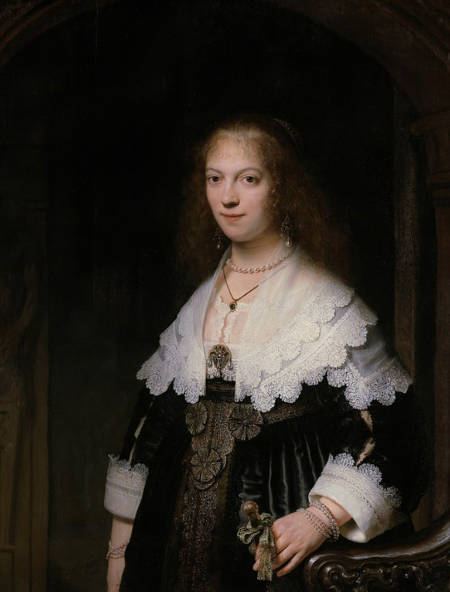
Rembrandt van Rijn
1639
Oil on panel, 107 x 82 cm,
Rijksmuseum, Amsterdam
Dutch paintings from this era, particularly portraits, reveal other features considered beautiful: delicate facial features, a smooth, high forehead (sometimes with hair pulled back), and soft, rounded cheeks. Hair was generally styled simply and modestly, often pulled back or covered with a coif or veil. Clothing styles also contributed to the overall aesthetic, with modest but finely made attire that communicated social standing without overt display. In portraits by artists such as Rembrandt van Rijn (1606–1669) (fig. 5) and Frans Hals (1580–1666) , women are often shown with gentle expressions and understated elegance, embodying a restrained yet dignified beauty that reflects Dutch cultural values of the time.
However, achieving this ideal of beauty was challenging due to many diseases, and smallpox was among the most dreaded of all, often leaving survivors with visible facial scars.
The prevalence of smooth, unblemished faces in these paintings raises suspicion, especially considering the frequent smallpox epidemics of the period. Furthermore, the absence of toothbrushes, orthodontists, and professional dentistry likely explains why most individuals posing for portraits kept their mouths closed.
In the seventeenth century, smallpox was one of the most prevalent diseases, leaving many survivors, particularly women, with pockmarked faces. Smallpox was highly contagious and frequently led to severe scarring, as its characteristic pustules caused lesions across the face and body. Those who survived often bore lifelong evidence of the disease in the form of deep, visible scars, which were especially stigmatizing in a society where physical appearance held significant social value, particularly for women.
This disfigurement could have substantial social and psychological impacts, given the period’s emphasis on outward appearance in defining women’s marriage prospects and social acceptance. Remedies were largely ineffective, and treatments focused more on covering scars than reversing the damage. Some women, especially those of wealth, attempted to mask scars with powders and creams, although the effectiveness was limited and sometimes detrimental to skin health. This marked a period when beauty standards often excluded individuals with visible scars, leading to a social divide where disease survivors faced challenges in both public life and marriage.
Pregnancy
In the seventeenth-century Netherlands, pregnancy was a significant aspect of women's lives, deeply intertwined with societal norms, medical practices, and cultural perceptions. During this period, Dutch Republic experienced a high birth rate, with families often having numerous children. Childbearing was considered a woman's primary role, and successful pregnancies were essential for familial lineage and economic stability. Midwives played a central role in managing pregnancies and childbirth. They were responsible for prenatal care, delivery, and postpartum support. In urban areas, midwifery was increasingly regulated; for instance, Amsterdam established formal midwifery training programs in the seventeenth century, aiming to improve maternal and infant health outcomes. These programs coincided with the advent of maternity hospitals throughout Europe.
 Fig. 6 Childbirth (Series/Portfolio: Marriage in the City) (Series/Portfolio: Marriage in the City)
Fig. 6 Childbirth (Series/Portfolio: Marriage in the City) (Series/Portfolio: Marriage in the City)(Le Mariage à la ville)
Abraham Bosse, Publisher: Jean I Leblond
1633
Etching with engraving, 29.2 × 37.8 cm.
Metropolitan Museum of Art, New York
A seventeenth-century illustration by Abraham Bosse (fig. 6) shows a standing man, presumably the husband, present at a birth—a previously forbidden practice due to taboos surrounding childbirth. This taboo has persisted throughout history, dating back to the early Christian era when women were linked with impurity. According to Pope Innocent III in the 12th century, women conceived with impurity, birthed in sorrow, and nursed in struggle. American feminist Adrienne Rich suggests that men were prohibited from witnessing childbirth due to this association with sin. Only in the twentieth century did the presence of husbands at births become more accepted.Ton van der Pennen, "Achterwerk in de Kast—op kraamvisite", last modified December 3, 2020, accessed November 6, 2024, .
Despite these advancements, medical knowledge remained limited, and childbirth was fraught with risks. Complications such as puerperal fever and hemorrhage were common, contributing to high maternal and infant mortality rates. The absence of effective antiseptics and antibiotics further exacerbated these dangers. Consequently, pregnancy was often accompanied by anxiety and a heightened awareness of mortality.
Pregnancy was supported by a network of female relatives, neighbors, and midwives who provided care and assistance. Traditional practices included specific dietary recommendations and the use of herbal remedies to promote health during pregnancy. Postpartum care was also vital, with customs such as the kraamvisite, where visitors would bring gifts and offer support to the new mother, reinforcing community bonds.
Pregnancy in Painting
The expert of Dutch 17th-century costume Maraike de WinkelMareiek de Winkel,v The Interpretation of Dress in Vermeer's Paintings," in exh. cat. Johannes Vermeer. Arthur K. Wheelock Jr. and Ben Broos, London and New Haven: Yale University Press, 1995, 330-332. wrote that in seventeenth-century Dutch painting, pregnancy was seldom depicted directly, a reflection of societal attitudes that regarded the visible signs of pregnancy as improper for public portrayal. Although many women were painted in their early years of marriage—a period when pregnancy was common—painters typically avoided showing them as visibly expectant. Dutch art, characterized by its restraint and focus on decorum, tended to emphasize modesty, leaving any suggestion of maternity understated and discreet. This approach aligned with a broader cultural preference for propriety, where the female form, especially in its maternal aspects, was concealed rather than celebrated in art.
De Winkel submits that in the few instances where pregnancy was implied, such as in Jan Steen's genre scenes, it was often depicted in a humorous or unflattering light, associating pregnant women with indulgence in eating or drinking. Even in these rare cases, pregnancy served more as a narrative device emphasizing excess rather than a celebration of maternity itself. Loose clothing, sometimes worn by female figures in these works, likely followed contemporary fashion rather than serving as an intentional reference to pregnancy. Thus, the portrayal of maternity remained subtle, shaped by the aesthetic and moral values of Dutch society, which preferred to allude to rather than display the condition openly.
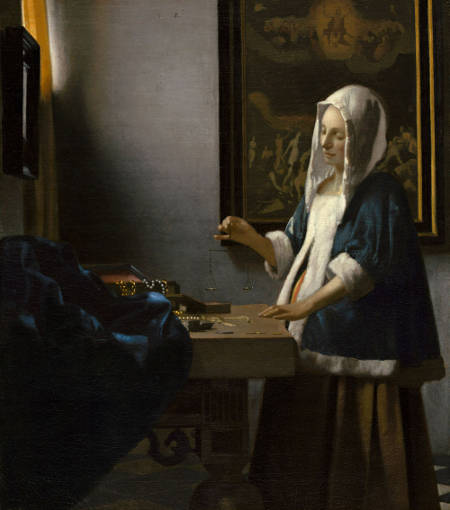
Johannes Vermeer
c. 1662–1665
Oil on canvas, 42.5 x 38 cm.
National Gallery of Art, Washington, D.C.
No mention of pregnancy in any of the early descriptions of the artist's paintings (for example, the sale catalogue of 1696) and only one, evidently, before the twentieth century.
The theory that the woman [in Woman Holding a Blalance] (fig. 9) is pregnant was first proposed by Carstensen and Putscher in 1971.Richard Carstensen and Marielene Putscher, "Ein Bild von Vermeer in medizinhistorischen Sicht," Deutsches Ärzteblatt-Ärtzliche Mitteilungen 68 (December 1971). "They concluded that the woman, following an old folk tradition, was weighing pearls to help determine the sex of her unborn child. Since then, many authors have accepted her pregnancy as fact, including WalshI. Jr. Walsh, "Vermeer," The Metropolitan Museum of Art Bulletin 31, no. 4 (Summer 1973, 79.). and Grimme (1974),Ernst Günther Grimme, Jan Vermeer van Delft (Cologne: DuMont Buchverlag, 1974). who, based on the supposed pregnancy, attempted to identify the model as Vermeer’s wife, Catharina Bolnes, the mother of his fourteen children. In 1983, Salomon suggested that a pregnant woman holding scales might have been interpreted as a Catholic response to the religious debate about the moment a Christian soul attains grace and salvation, a theory later accepted by Peter Sutton (1984).Masters of Seventeenth-Century Dutch Genre Painting, ed. Peter C. Sutton (Philadelphia: Museum of Art, 1984), exhibition catalog. In my opinion, it seems unlikely that the woman is pregnant. As seen in numerous paintings by Vermeer’s contemporaries, Dutch fashions in the mid-seventeenth century often favored a bulky silhouette. The short jacket the woman wears, called a pet-en-l’air,The pet-en-l'air was an 18th-century French women's garment notable for its short length and distinctive pleated back known"as "Watteau pleats." Serving as a shorter version of the robe à la française, it ended at the hip rather than extending to the floor. Typically worn over a coordinating petticoat, the pet-en-l'air was favored for informal daytime attire among the upper classes in France. covered a bodice and a thickly padded skirt. The impression created—a forward-thrusting stomach—was evidently a desirable feature."Arthur K. Wheelock Jr. and Ben Broos, Johannes Vermeer (London and New Haven: Yale University Press, 1995), note 3, 144.